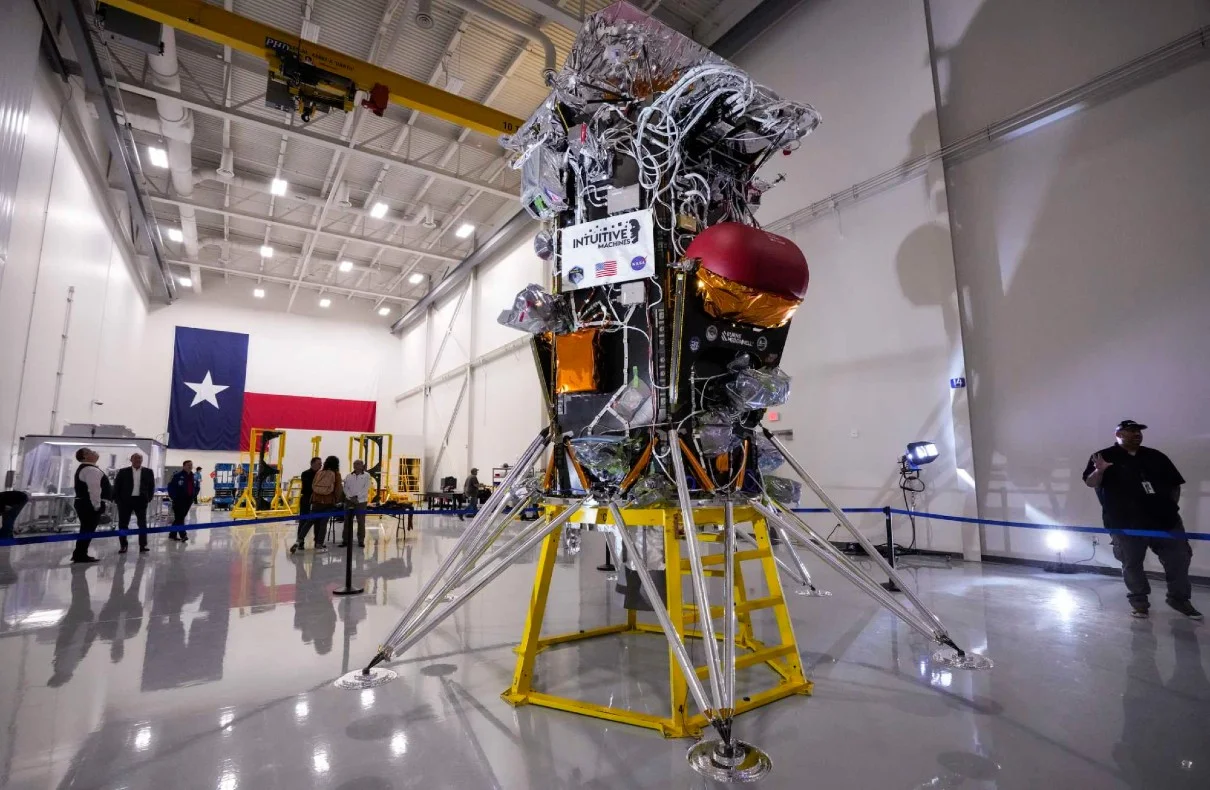
The quest to explore the moon and eventually return astronauts to its surface has taken a significant step forward with Intuitive Machines’ upcoming lunar lander mission. This groundbreaking endeavor, part of NASA’s Artemis program, aims to deliver scientific payloads and pave the way for future exploration and potential resource utilization.
Intuitive Machines, a Houston-based company, is preparing to launch its spacecraft, named Odysseus, on a historic mission to the moon. This will mark the first landing by the United States since the Apollo missions in 1972 and the first-ever commercial spacecraft to touch down on the lunar surface. With the support of NASA, which has several science experiments onboard, Intuitive Machines is set to deliver these payloads and make significant contributions to our understanding of the moon.
Odysseus is targeting the moon’s south pole as its landing site, a region of great interest to NASA due to the presence of water in the form of ice in its permanently shadowed craters. This water resource could potentially support future human missions and serve as a valuable asset for sustained lunar exploration. By exploring this region, Intuitive Machines aims to unlock the mysteries of the moon’s south pole and contribute to NASA’s efforts to establish lunar bases.
Europa: A Moon of Jupiter and Its Potential Habitability
The Intuitive Machines lunar lander mission exemplifies the increasing involvement of the commercial space industry in space exploration. NASA has embraced private contractors not only for cargo and crew transportation to the International Space Station but also for the development of spacecraft capable of landing astronauts on the moon. Additionally, the corporate sector is being tapped to develop habitats that could potentially replace the aging space station in Earth’s orbit. This collaborative approach between NASA and private enterprises holds the promise of opening up new economic and scientific opportunities in space.
Undertaking a lunar landing is an immensely challenging endeavor. Both NASA and commercial space companies have faced setbacks and delays in recent missions. Intuitive Machines’ lunar lander mission itself has experienced delays, as technical issues and the development of necessary equipment have required additional time. However, these setbacks serve as valuable learning opportunities, enabling the refinement of technologies and processes to ensure safer and more successful future missions.
NASA’s Artemis program, which encompasses various lunar missions, has encountered its share of delays. The Artemis II mission, which aimed to send a crew of four around the moon, has been postponed to September 2025 due to the need for further study of Orion’s heat shield. Similarly, Artemis III, the mission set to transport astronauts to the lunar surface, has been pushed back to no earlier than September 2026 due to delays in SpaceX’s Starship spacecraft development and spacesuit development by Axiom Space. Safety remains the top priority, and NASA is committed to launching when ready.
Odysseus, the Intuitive Machines lunar lander, is a phone-booth-sized spacecraft that will be carried to space on a SpaceX Falcon 9 rocket. Once separated from the rocket, the lander will employ special cameras to autonomously orient itself, ensuring its solar arrays are positioned correctly to harness solar power. Throughout the journey, the spacecraft will make course corrections using its propulsion system, similar to a car driver making minor adjustments along a straight road. These adjustments are crucial to ensure the lander reaches its intended lunar orbit.
As Odysseus approaches the moon, it will fire its engine to enter an orbit approximately 62 miles above the lunar surface. This orbit will be maintained for several passes, during which the lander will face alternating extremes of heat and cold as it transitions between sunlight and darkness. The spacecraft will temporarily lose communication with the ground during each orbit when the moon blocks its radio signal. Despite these challenges, the lander’s systems are designed to withstand these harsh conditions and continue functioning.
For the final descent, Odysseus will ignite its engine, gradually reducing its speed and altitude from 62 miles to just over six miles above the lunar surface. Throughout this descent, the lander’s cameras and lasers will provide vital data to its onboard navigation computers, which will autonomously guide it to a safe landing site. As it nears the surface, the lander will adjust its position to a vertical orientation with its landing legs pointed downward. To ensure a successful landing, the spacecraft relies on inertial measurement rather than cameras or sensors, analogous to closing your eyes and relying on your inner ear to navigate the last three feet to a door. The anticipated landing speed is a gentle three feet per second, or approximately 2 mph.
Jeff Koons Moon Sculptures: A Monumental Journey to the Lunar Surface
Odysseus carries several scientific payloads from NASA, including an instrument that will capture images of the dust plume generated by the lander’s engines during landing. This data will help scientists better understand the effects of landings on the moon’s surface and environment, particularly as future missions aim to land multiple spacecraft in close proximity. Additionally, a camera system developed by Embry-Riddle Aeronautical University will be deployed from the lander to capture images of the vehicle during the landing sequence, providing valuable insights for future mission planning and design.
Intuitive Machines’ lunar lander mission represents a critical milestone in lunar exploration and commercial space endeavors. The success of this mission will inspire further advancements in technology, safety, and collaboration between NASA and private industry. Intuitive Machines is already planning two additional lunar lander missions, IM-2 and IM-3, which will build upon the lessons learned from IM-1. With each mission, the company aims to refine its technologies, expand its capabilities, and contribute to humanity’s ongoing exploration of the moon.
